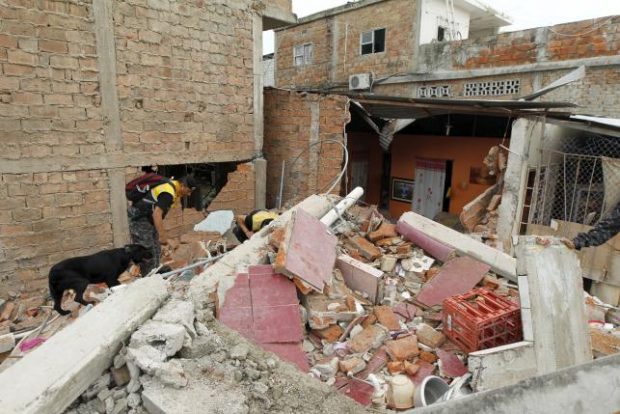Ecuador earthquake kills 233 and destroys whole coast zone

The death toll from Ecuador’s biggest earthquake in decades soared to at least 233 on Sunday as rescuers using tractors and bare hands hunted desperately for survivors in shattered coastal towns.
The 7.8 magnitude quake struck off the Pacific coast on Saturday and was felt around the Andean nation of 16 million people, causing panic as far away as the highland capital Quito and collapsing buildings and roads in a swath of western towns.
President Rafael Correa, rushing home from a trip to Italy, said the number of fatalities jumped on Sunday to 233.
“The immediate priority is to rescue people in the rubble,” he said via Twitter. “Everything can be rebuilt, but lives cannot be recovered, and that’s what hurts the most.”
More than 1,500 people were injured, authorities said.
Coastal areas nearest the quake were worst affected, especially Pedernales, a rustic tourist spot with beaches and palm trees, which appeared largely flattened.
“There are people trapped in various places, and we are starting rescue operations,” Vice President Jorge Glas said on Sunday morning before boarding a plane to the area.
A state of emergency was declared in six provinces.
Authorities said there had been 163 aftershocks, mainly in the Pedernales area.
PEDERNALES ‘DESTROYED’
One photo on social media purporting to be the entrance to Pedernales showed a torn-up road with a crushed car in the middle and people standing behind.
Local TV station Televicentro broadcast images from Pedernales showing locals using a small tractor to remove rubble and also searching with their hands for people buried underneath.
Women cried after a corpse was pulled out. Locals said children were trapped.
One man begged for help: “Pedernales is destroyed.”
Many people spent the night on the streets.
In Guayaquil, Ecuador’s largest city, rubble lay in the streets and a bridge fell on top of a car.
“It was horrible, it was as if it was going to collapse like cardboard,” said Galo Valle, 56, who was guarding a building in the city where windows fell out and parts of walls broke.
“I prayed and fell to my feet to ask God to protect me.”
About 13,500 security force personnel were mobilized to keep order around Ecuador, and $600 million in credit from multilateral lenders was immediately activated for the emergency, the government said.
Ramon Solorzano, 46, a car parts merchant in the coastal city of Manta, headed away from built-up areas with his family. Photos from Manta showed Red Cross workers arriving, police hunting through debris, a smashed sculpture and badly damaged buildings.
“Most people are out in the streets with backpacks on, heading for higher ground,” Solorzano said, speaking in a trembling voice on a WhatsApp phone call. “The streets are cracked. The power is out and phones are down.”
Parts of Quito were without power or phone service for several hours, but the city government said those services had been restored and there were no reports of casualties in the city.
WORST QUAKE IN 37 YEARS
The government called it the worst quake in the country since 1979. In that disaster, 600 people were killed and 20,000 injured, according to the U.S. Geological Survey.
In international aid, Venezuela, Chile and Mexico were sending personnel and supplies, the Correa government said.
A tsunami warning was lifted on Saturday night, but coastal residents were urged to seek higher ground in case tides rise.
“At first it (the quake) was light, but it lasted a long time and got stronger,” said Maria Jaramillo, 36, a resident of Guayaquil, describing windows breaking and pieces falling off roofs.
“I was on the seventh floor and the light went off in the whole sector, and we evacuated. People were very anxious in the street. … We left barefoot.”
The OPEC member country said oil production was not affected, but closed its main refinery of Esmeraldas, located near the epicentre, as a precaution.
Residents on the Galapagos islands far off Ecuador’s coast, which are home to numerous rare species, said they had not been affected by the quake, though they were anxious.
The Ecuadorean quake followed two large and deadly quakes that struck Japan since
Thursday. Both countries are located on the seismically active “Ring of Fire” that circles the Pacific, but according to the U.S. Geological Survey large quakes separated by such long distances would probably not be related.
“Even the earth’s rocky crust is not rigid enough to transfer stress efficiently over thousands of miles,” it said on its website. Quakes can cause other big quakes within a range of hundreds of miles, but can cause only small, brief quakes at a distance of thousands of miles, it said.
[su_note note_color=”#fefccb”]The views expressed in this article are the author’s own and do not necessarily reflect Libyan News’s editorial policy.[/su_note]
How to submit an Op-Ed: Libyan Express accepts opinion articles on a wide range of topics. Submissions may be sent to oped@libyanexpress.com. Please include ‘Op-Ed’ in the subject line.
- Registry officials held in citizenship probe - January 26, 2025
- Libya under UN pressure over prison official’s ICC warrant - January 26, 2025
- Hamad government sets conditions for foreign car entry - January 26, 2025


